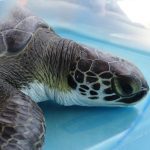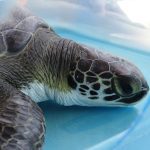Research Area(s)
Physiological ecology of marine mammals through the study of their bioenergetics, feeding ecology, and habitat utilization.
BACKGROUND
Graham Worthy is a UCF Pegasus Professor, Provosts Distinguished Professor of Biology and the Hubbs-SeaWorld Endowed Professor of Marine Mammalogy at the University of Central Florida. He is also the Director of the Physiological Ecology and Bioenergetics Lab in the Department of Biology. He holds a B.Sc. in Zoology from the University of Guelph in Ontario Canada, as well as a M.Sc. and Ph.D. in Environmental Physiology from the same institution. After finishing his Ph.D. he went to the University of California at Santa Cruz on a 3 year ONR Postdoctoral Fellowship. Professor Worthy was on the faculty of Texas A&M University at Galveston between 1990 and 2001 where he achieved the rank of Full Professor. During that same time, he was also President and State Director of the Texas Marine Mammal Stranding Network – one of the largest marine mammal response networks in the world. In 2001 he was recruited to the University of Central Florida. He was one of the founders of the Comparative Nutrition Society (1995) and subsequently served as Vice-President (2000-2002) and President (2002-2004). He was a member of the Board of Governors for the Society for Marine Mammalogy (1992-1995) and served as the Conference Chairman for two of their biennial meetings (1989 and 1993). He is currently a member of the Editorial Review Board of both Frontiers in Aquatic Physiology and Southeastern Naturalist. He has served on many boards and advisory panels on issues relating to marine mammal strandings, manatee conservation, and the 2010 Deepwater Horizon oil spill and is currently co-Chair of the North American Region of IUCN Sirenian Specialist Group.
Professor Worthy’s research interests focus on understanding marine ecosystem function, and ultimately ocean health, by examining the interrelationships between different species and how those species respond to natural and anthropogenic perturbations and how individual animals derive their nutritional needs from their environment by studying their energetics, growth, and nutrition. To achieve this he has undertaken studies on a variety of marine mammal species, including pinnipeds, cetaceans and sirenians, through laboratory and field based investigations designed to examine the capabilities of different species to withstand normal seasonal variation in their environment as well as understanding how human induced change can impact them.
In 2015 Dr. Worthy authored a successful proposal, submitted to the UCF Faculty Cluster Initiative, to hire five interdisciplinary faculty to form the core of a Sustainable Coastal Systems cluster. This initiative ultimately led to the development of the National Center for Integrated Coastal Research (NCICR) which was approved in 2017. The mission of the NCICR is to: 1) lead a world-class effort to assess natural and human-related impacts to the health, restoration, and sustainability of coastal systems; 2) conduct long-term, integrated, multi-disciplinary research with strategic external partners; 3) communicate findings in an effective and efficient way to advance scientific inquiry, support resource conservation and management, and to assist policy makers; 4) communicate information to the general public; and 5) train the next generation of scientists to enter the workforce as effective researchers and science emissaries, with interdisciplinary skills that can bridge the gap between science and society, serving as translators and communicators. The creation of this Center, with 40 faculty drawn from 12 departments in 7 Colleges, has positioned UCF to be a global leader integrating science and social needs into more effective economic development and planning, environmental stewardship, hazard mitigation planning, and public policy development.
PUBLICATIONS
- Hall, M., E. Hoffman, R. Dyer, and G.A.J. Worthy. Submitted. Using seascape genetic analysis to detect weak patterns in the genetically depauperate Florida manatee. Animal Conservation.
- Stolen, M.K., W. Noke-Durden, T. Jablonski, G.A.J. Worthy, R. Paperno, and C.A. Jacoby. 2025. An unusual mortality event for bottlenose dolphins: links to altered diets resulting from ecological changes. Frontiers in Marine Science. https://doi:10.3389/fmars.2025.1531742
- Lanyon, J.M, H.L. Sneath, W.H. Blanshard, T. Long, G.A.J. Worthy and D.T. Booth. 2024. How much seagrass does a dugong need? Metabolic rate of live wild dugongs, Dugong dugon, determined through indirect calorimetry (oxygen consumption). Marine Mammal Science 2024; e13190. https://doi.org/10.1111/mms.13190
- Long, C.A., G.A.J. Worthy, R. Paperno, S.A. Ceriani, and K.L. Mansfield. 2024. Harmful algal bloom impacts on juvenile green turtle foraging ecology: insights from stable isotope analysis. Marine Ecology Progress Series 728:59-73. https://doi.org/10.3354/meps14488
- Rosen, D.A.S. and G.A.J. Worthy. 2018. Nutrition and energetics. Chapter 29 in Handbook of Marine Mammal Medicine. 3rd Edition. Gulland, F., L. Dierauf and K.L. Whitman. (eds.). CRC Press, Boca Raton, FL. 1124 p.
- Evacitas, F.C., W-Y. Kao, G.A.J. Worthy, L.-S. Chou. 2017. Annual variability in dentin d15N and d13C ratios reveal sex differences in weaning age and feeding habits in Risso’s dolphins (Grampus griseus). Marine Mammal Science 33:748-770. https://doi.org/10.1111/mms.12396
- Evacitas, F.C., G.A.J. Worthy, and L.-S. Chou. 2016. Alternative method for subsampling annual dentin layers in small mammalian teeth for stable isotope analysis. Journal of Archaeological Science 66:112-119. https://doi.org/10.1016/j.jas.2016.01.001
- Litz, J., M. Baran, R. Carmichael, K. Colegrove, S. Fire, E. Fougeres, R. Hardy, S. Holmes, W. Jones, B. Mase-Guthrie, D. Odell, D. Shannon, J. Saliki, S. Shippee, S. Smith, E. Stratton, S. Bowen-Stevens, M. Tumlin, H. Whitehead, G.A.J. Worthy, S. Venn-Watson, and T. Rowles. 2014. Review of historical unusual mortality events (UMEs) in the Gulf of Mexico (1990-2009): providing context for the multi-year northern Gulf of Mexico cetacean UME declared in 2010. Diseases of Aquatic Organisms 112:161-175. https://doi.org/10.3354/dao02807
- Browning, N.E., V.C. Cockcroft and G.A.J. Worthy. 2014. Resource partitioning among South African delphinids. Journal of Experimental Marine Biology and Ecology 457:15-21. https://doi.org/10.1016/j.jembe.2014.03.016
- Browning, N.E., S. McCulloch, G.D. Bossart and G.A.J. Worthy. 2014. Fine-scale population structure of estuarine bottlenose dolphins (Tursiops truncatus) assessed using stable isotope ratios and fatty acid signature analyses. Marine Biology 161:1307-1317.
- Browning, N.E., C. Dold, J. I-Fan and G.A.J. Worthy. 2014. Isotope turnover rates and diet-tissue discrimination in skin of ex situ bottlenose dolphins (Tursiops truncatus). Journal of Experimental Biology 217: 214-221. https://doi.org/10.1242/jeb.093963
- Hoopes, L.A., L.D. Rea, A. Christ and G.A.J. Worthy. 2014. No evidence of metabolic depression in Western Alaskan juvenile Steller sea lions (Eumetopias jubatus). PLoS ONE 9(1): e85339. https://doi.org/10.1371/journal.pone.0085339
- Worthy, G.A.J. and T.A.M. Worthy. 2014. Digestive efficiencies of ex situ and in situ West Indian manatees (Trichechus manatus latirostris). Physiological and Biochemical Zoology 87:77-91. https://www.journals.uchicago.edu/doi/abs/10.1086/673545
- Worthy, G.A.J., T.A.M. Worthy, P.K. Yochem and C. Dold. 2014. Basal metabolism of an adult male killer whale (Orcinus orca). Marine Mammal Science 30:1229–1237. https://doi.org/10.1111/mms.12091
- Carmichael, R.H., M. Graham, A. Aven, G.A.J. Worthy and S. Howden. 2012. Were multiple stressors a ‘perfect storm’ for Northern Gulf of Mexico bottlenose dolphins (Tursiops truncatus) in 2011? PLoS One 7(7): e41155. doi:10.1371/journal.pone.
- Witteveen, B.H., G.A.J. Worthy, R.J. Foy, and K.M. Wynne. 2011. Modeling the diet of humpback whales: an approach using stable carbon and nitrogen isotopes in a Bayesian mixing model. Marine Mammal Science: in press. DOI: 10.1111/j.1748-7692.2011.00508.x
- Witteveen, B.H., G.A.J. Worthy, K.M. Wynne, A.C. Hirons, A.G. Andrews, and R.W. Markel. 2011. Trophic levels of North Pacific humpback whales (Megaptera novaeangliae) through analysis of stable isotopes: implications on prey and resource quality. Aquatic Mammals 37:101-110.
- Alves-Stanley, C.D., G.A.J. Worthy and R.K. Bonde. 2010. Feeding preferences of West Indian manatees in Florida, Belize, and Puerto Rico as indicated by stable isotope analysis. Marine Ecology Progress Series 402:255-267.
- Witteveen, B.H., G. A.J. Worthy, and J. Roth. 2009. Using stable carbon and nitrogen isotope ratios to describe migratory movements of breeding North Pacific humpback whales. Marine Ecology Progress Series 393:173-183.
- Alves-Stanley, C.D. and G.A.J. Worthy. 2009. Carbon and nitrogen stable isotope turnover rates and diet-tissue discrimination in Florida manatees (Trichechus manatus latirostris). Journal of Experimental Biology 212:2349-2355.
- Witteveen, B.H., G.A.J. Worthy, K.M. Wynn, and J.D. Roth. 2009. Population structure of North Pacific humpback whales on their feeding grounds revealed by stable carbon and nitrogen isotope ratios. Marine Ecology Progress Series 379:299-310.
- Smith, H.S. and G.A.J. Worthy. 2006. Stratification and intra- and inter-specific differences in fatty acid composition in common dolphin (Delphinus sp.) blubber. Comparative Biochemistry and Physiology, Part B 143: 486-499.
- Samuel, A.M. and G.A.J. Worthy. 2004. Variability in fatty acid composition of bottlenose dolphin (Tursiops truncatus) blubber as a function of body site, season, and reproductive status. Canadian Journal of Zoology 82:1933-1942.
- Kurle, C.M. and G.A.J. Worthy. 2002. Variations in stable carbon and nitrogen isotope ratios in northern fur seal (Callorhinus ursinus) tissues: Implications for dietary and migratory reconstructions. Marine Ecology Progress Series 236:289-300.



